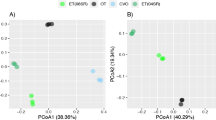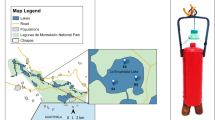Abstract
We carried out a detailed study in five stratified lakes in the karstic regions of NE Spain along a redox gradient combining vertical profiles of inorganic carbon dioxide fixation and analysis of microbial (bacteria and archaea) community composition determined by 16S rRNA gene fingerprinting (DGGE), microscopic counts, and pigment analysis. High rates of non-photosynthetic (i.e., “dark”) inorganic carbon incorporation were detected mostly at deeper layers after short-term in situ incubations at noon. Significant contribution of dark CO2 incorporation was observed at the whole lake level for the single time sampling, ranging between 4 and 19% of total carbon fixation measured, and up to 31% in the case of a meromictic basin. Good agreement was found between vertical patterns in redox conditions and the different microbial diversity descriptors (DGGE band sequencing, microscopic analysis, and pigment data), showing large vertical changes in microbial community composition covering a wide range of phylogenetic diversity. Cyanobacteria, Alpha and Beta-Proteobacteria, Actinobacteria, Flavobacteria and Flectobacillaceae were the most frequently recovered groups in the DGGE from oxygenated water masses. In anoxic waters, we found Beta-Proteobacteria mostly of the Rhodoferax group, Gamma-Proteobacteria (Chromatiaceae), Delta-Proteobacteria related to different sulfate reducing bacteria, Chlorobiaceae, and anaerobic Bacteroidetes spread among the Bacteroidales, Flavobacteriales and Saprospiraceae. However, as a whole, we did not find any significant correlation between dark fixation rates and either nutrient distribution and microbial community composition in the study lakes. All of this suggests that (1) different physiologies and ecologies are simultaneously contributing to the process (2) more sensitive methods are needed and more specific compounds measured and (3) some of the non-specialist microbial populations detected may carry out carbon dioxide assimilation in the dark under in situ conditions.







Similar content being viewed by others
References
Alonso-Sáez L, Galand PE, Casamayor EO, Pedrós-Alió C, Bertilsson S (2010) High bicarbonate fixation in the dark by arctic bacteria. ISME J 4:1581–1590
APHA–AWWA–WEF (1992) Standard methods for the examination of water and wastewater. 18th edn. American Public Health Association. Washington D.C.
Auguet JC, Borrego CM, Bañeras L, Casamayor EO (2008) Fingerprinting the genetic diversity of the biotin carboxylase gene (accC) in aquatic ecosystems as a potential marker for studies of carbon dioxide assimilation in the dark. Environ Microbiol 10:2527–2536
Auguet JC, Barberán A, Casamayor EO (2010) Global ecological patterns in uncultured Archaea. ISME J 4:182–190
Barberán A, Casamayor EO (2010) Global phylogenetic community structure and beta-diversity patterns of surface bacterioplankton metacommunities. Aquat Microb Ecol 59:1–10
Barberán A, Casamayor EO (2011) Euxinic freshwater hypolimnia promote bacterial endemicity in continental areas. Microb Ecol 61:465–472
Borrego CM, Garcia-Gil LJ, Vila XP, Figueras JB, Abella CA (1997) Distribution of bacteriochlorophyll homologues in natural populations of brown-colored phototrophic sulfur bacteria. FEMS Microbiol Ecol 24:301–309
Brock TD, Brock ML, Bott TL, Edwards MR (1971) Microbial life at 90°C: the sulfur bacteria of Boulder Spring. J Bacteriol 107:303–314
Camacho A (2006) On the occurrence and ecological features of deep chlorophyll maxima (DCM) in Spanish stratified lakes. Limnetica 25:453–478
Camacho A, Vicente E (1998) Carbon photoassimilation by sharply stratified phototrophic communities at the chemocline of Lake Arcas (Spain). FEMS Microbiol Ecol 25:11–22
Camacho A, Erez J, Chicote A, Florin M, Squires MM, Lehmann C, Bachofen R (2001) Microbial microstratification, inorganic carbon photoassimilation and dark carbon fixation at the chemocline of the meromictic Lake Cadagno (Switzerland) and its relevance to the food web. Aquat Sci 63:91–106
Camacho A, Miracle MR, Vicente E (2003) Which factors determine the abundance and distribution of picocyanobacteria in inland waters? A comparison among different types of lakes and ponds. Arch Hydrobiol 157:321–338
Casamayor EO (2010) Vertical distribution of planktonic autotrophic thiobacilli and dark CO2 fixation rates in lakes with oxygen–sulfide interfaces. Aquat Microb Ecol 59:217–228
Casamayor EO, Schäfer H, Bañeras L, Pedrós-Alió C, Muyzer G (2000) Identification of and spatio-temporal differences between microbial assemblages from two neighboring sulfurous lakes: comparison by microscopy and denaturing gradient gel electrophoresis. Appl Environ Microbiol 66:499–508
Casamayor EO, García-Cantizano J, Mas J, Pedrós-Alió C (2001a) Microbial primary production in marine oxic/anoxic interfaces: main role of dark fixation in the Ebro River salt wedge estuary. Mar Ecol Prog Ser 215:49–56
Casamayor EO, Muyzer G, Pedrós-Alió C (2001b) Composition and temporal dynamics of planktonic archaeal assemblages from anaerobic sulfurous environments studied by 16S rDNA denaturing gradient gel electrophoresis and sequencing. Aquat Microb Ecol 25:237–246
Casamayor EO, Pedrós-Alio C, Muyzer G, Amann R (2002) Microheterogeneity in 16S ribosomal DNA-defined bacterial populations from a stratified planktonic environment is related to temporal changes and to ecological adaptations. Appl Environ Microbiol 68:1706–1714
Casamayor EO, J García-Cantizano, C Pedrós-Alió (2008) CO2 fixation in the dark by photosynthetic bacteria in sulfide rich stratified lakes with oxic–anoxic interfaces Limnol Oceanogr 53:1193–1203
Dijkhuizen L, Harder W (1984) Current views on the regulation of autotrophic carbon dioxide fixation via the Calvin cycle in bacteria. Antonie van Leeuwenhoek 50:473–487
Dumestre JF, Casamayor EO, Massana R, Pedrós-Alió C (2002) Changes in bacterial and archaeal assemblages in an equatorial river induced by the water eutrophication of Petit Saut dam reservoir (French Guiana). Aquat Microb Ecol 26:209–221
Estrada M, Hendriksen P, Gasol JM et al (2004) Diversity of planktonic photoautotrophic microorganisms along a salinity gradient as depicted by microscopy, flow cytometry, pigment analysis and DNA-based methods. FEMS Microbiol Ecol 49:281–293
Ferrera I, Massana R, Casamayor EO, Balagué V, Sánchez O, Pedrós-Alió C, Mas J (2004) High-diversity biofilm for the oxidation of sulfide-containing effluents. Appl Microbiol Biotechnol 64:726–734
García-Cantizano J, Casamayor EO, Gasol JM, Guerrero R, Pedrós-Alió C (2005) Partitioning of CO2 incorporation among guilds of microorganisms in lakes with oxic/anoxic interfaces and estimation of in situ specific growth rates. Microb Ecol 50:230–241
Garcia-Gil LJ, Vicente E, Camacho A, Borrego CM, Vila X, Cristina XP, Rodriguez-González J (1999) Vertical distribution of photosynthetic sulphur bacteria linked to saline gradients in Lake El Tobar (Cuenca, Spain). Aquat Microb Ecol 20:299–303
Glaubitz S, Lüders T, Abraham W-R, Jost G, Jürgens K, Labrenz M (2009) 13C-isotope analyses reveal that chemolithoautotrophic Gamma- and Epsilonproteobacteria feed a microbial food web in a pelagic redoxcline of the central Baltic Sea. Environ Microbiol 11:326–337
Golterman HL (2004) The chemistry of phosphate and nitrogen compounds in sediments. Springer Netherlands. 280 pp
Golterman HL, Clymo RS, Ohnstad MAM (1978) Methods for physical and chemical analysis of freshwater. IBP Handbook no. 8. Blackwell Scientific Publications, Oxford, UK
Gorlenko VM, Dubinina GA, Kuznetsov SL (1983) The ecology of aquatic micro-organisms. E. Schweizerbart’sche Verlagsbuchhandlung (Nägele u. Obermiller), Stuttgart
Guerrero R, Montesinos E, Pedrós-Alió C, Esteve I, Mas J, van Gemerden H et al (1985) Phototrophic sulfur bacteria in two Spanish lakes: vertical distribution and limiting factors. Limnol Oceanogr 30:919–931
Habicht KS, Miller M, Cox RP, Frigaard NU, Tonolla M, Peduzzi S, Falkenby LG, Andersen JS (2011) Comparative proteomics and activity of a green sulfur bacterium through the water column of Lake Cadagno, Switzerland. Environ Microbiol 13:203–215
Jost G, Martens-Habbena W, Pollehne F, Schnetger B, Labrenz M (2010) Anaerobic sulfur oxidation in the absence of nitrate dominates microbial chemoautotrophy beneath the pelagic chemocline of the eastern Gotland Basin, Baltic Sea. FEMS Microbiol Ecol 71:226–236
Labrenz M, Jost G, Pohl C, Beckmann S, Martens-Habbena W, Jurgens K (2005) Impact of different in vitro electron donor/acceptor conditions on potential chemolithoautotrophic communities from marine pelagic redoxclines. Appl Environ Microbiol 71:6664–6672
Llirós M, Casamayor EO, Borrego CM (2008) High archaeal richness in the water column of a freshwater sulphurous karstic lake along an inter-annual study. FEMS Microbiol Ecol 66:331–342
Llobet-Brossa E, Rosselló-Mora R, Amann R (1998) Microbial community composition of Wadden Sea sediments as revealed by fluorescence in situ hybridization. Appl Environ Microbiol 64:2691–2696
Lunina ON, Bryantseva IA, Akimov VN, Rusanov II, Rogozin DYu, Barinova ES, Lysenko AM, Pimenov NV (2007) Seasonal changes in the structure of the anoxygenic photosynthetic bacterial community in Lake Shunet, Khakassia. Microbiology 76:368–379
Marschall E, Jogler M, Henssge U, Overmann J (2010) Large-scale distribution and activity patterns of an extremely low-light-adapted population of green sulfur bacteria in the Black Sea. Environ Microbiol 12:1348–1362
Mas J, van Gemerden H (1995) Storage products in purple and green sulfur bacteria. In: Blankenship RE, Madigan MT, Bauer CE (eds) Anoxygenic photosynthetic bacteria. Kluwer Academic Publishers, Dordretch, pp 973–990
Morris I, Yentsch CM, Yentsch CS (1971) The physiological state with respect to nitrogen of phytoplankton from low-nutrient subtropical water as measured by the effect of ammonium ion on dark carbon dioxide fixation. Limnol Oceanogr 16:859–868
Musat N, Halm H, Winterholler B, Hoppe P, Peduzzi S, Hillion F, Horreard F, Amann R, Jørgensen BB, Kuypers MM (2008) A single-cell view on the ecophysiology of anaerobic phototrophic bacteria. PNAS 105:17861–17866
Overmann J, Cypionka H, Pfennig N (1992) An extremely low-light adapted phototrophic sulfur bacterium from the chemocline of the Black Sea. Limnol Oceanogr 37:150–155
Pinckney JL, Millie DF, Howe KE, Paerl HW, Hurley JP (1996) Flow scintillation counting of 14C-labeled microalgal photosynthetic pigments. J Plankton Res 18:1867–1880
Porter KG, Feig YS (1980) The use of DAPI for identifying and counting aquatic microflora. Limnol Oceanogr 25:943–948
Prakash A, Sheldon RW, Sutcliffe WH Jr (1991) Geographic variation of oceanic 14C dark uptake. Limnol Oceanogr 36:30–39
Reichenbach H (2006) The order Cytophagales, p. 3631–3675. In: Dworkin M, Falkow S, Rosenberg E, Schleifer K-H, Stackebrandt E (eds). The Prokaryotes 7, pp 549–590. Springer, Berlin
Rodrigo MA, Vicente E, Miracle MR (2000) The role of light and concentration gradients in the vertical stratification and seasonal development of phototrophic bacteria in a meromictic lake. Arch Hydrobiol 148:533–548
Shively JM, van Keulen G, Meijer WG (1998) Something from almost nothing: carbon dioxide fixation in chemoautotrophs. Annu Rev Microbiol 52:191–230
Sorokin YI (1972) The bacterial population and the processes of hydrogen sulphide oxidation in the Black Sea. J Cons Int Exp Mer 34:423–454
Tonolla M, Peduzzi R, Hahn D (2005) Long-term population dynamics of phototrophic sulfur bacteria in the chemocline of Lake Cadagno. Switzerland Appl Environ Microbiol 71:3544–3550
Tuttle JH, Jannasch HW (1979) Microbial dark assimilation of CO2 in the Cariaco Trench. Limnol Oceanogr 24:746–753
Van Gemerden H (1974) Coexistence of organisms competing for the same substrate: an example among the purple sulfur bacteria. Microb Ecol 1:104–119
Van Gemerden H, Mas J (1995) Ecology of phototrophic sulfur bacteria. In: Blankenship RE, Madigan MT, Bauer CE (eds) Anoxygenic photosynthetic bacteria. Kluwer Academic Publishers, Dordretch, pp 49–85
Van Heukelem L, Lewitus AJ, Kana TM, Craft NE (1994) Improved separations of phytoplankton pigments using temperature-controlled high performance liquid chromatography. Mar Ecol Prog Ser 114:303–313
Vicente E, Camacho A, Rodrigo MR (1993) Morphometry and physico-chemistry of the crenogenic meromictic lake El Tobar (Spain). Verh Internat Verein Limnol 25:698–704
Acknowledgments
This research was supported by projects VIARC REN2003-08333 and CRENYC CGL2006-12058 to EOC and CBM, from the Spanish Ministerio de Ciencia e Innovación (MICINN), and CONSOLIDER-INGENIO 2010 project GRACCIE CSD2007-00067 from MICINN. We thank A. García, MC Gutiérrez, and MA Vich for excellent technical and field assistance. We also thank the constructive comments made by two anonymous reviewers and the editor.
Author information
Authors and Affiliations
Corresponding author
Electronic supplementary material
Below is the link to the electronic supplementary material.
Rights and permissions
About this article
Cite this article
Casamayor, E.O., Llirós, M., Picazo, A. et al. Contribution of deep dark fixation processes to overall CO2 incorporation and large vertical changes of microbial populations in stratified karstic lakes. Aquat Sci 74, 61–75 (2012). https://doi.org/10.1007/s00027-011-0196-5
Received:
Accepted:
Published:
Issue Date:
DOI: https://doi.org/10.1007/s00027-011-0196-5
Keywords
Profiles
- Marc Llirós View author profile
- Antonio Camacho View author profile




